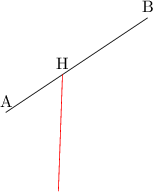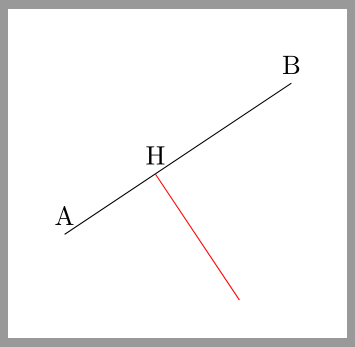|
Mal eine dumme Frage, wie zeichne ich eigentlich eine Senkrechte auf AB, die vom Punkt H weggeht? Ich dachte eigentlich, ich wüsste wie das geht. Öffne in Overleaf
\documentclass[margin=5mm, tikz]{standalone} \usepackage{tikz} \usetikzlibrary{calc} \begin{document} \begin{tikzpicture}[] \draw[] (0,0) coordinate[label=A](A) -- (3,2) coordinate[label=B](B); \coordinate[label=H](H) at ($(A)!0.4!(B)$); %\draw[red, shorten >=-3cm] (H) -- ($(A)!(H)!-90:(B)$); \draw[red] (H) -- ($(A)!2cm!-90:(H)$); \end{tikzpicture} \end{document} |
|
Das Problem liegt in Du musst also Öffne in Overleaf
\documentclass[margin=5mm, tikz]{standalone} \usetikzlibrary{calc} \begin{document} \begin{tikzpicture} \draw(0,0) coordinate[label=A](A) -- (3,2) coordinate[label=B](B); \coordinate[label=H](H) at ($(A)!0.4!(B)$); \draw[red] (H) -- ($(H)!2cm!90:(A)$); \end{tikzpicture} \end{document} Das lässt sich aber auch ohne Öffne in Overleaf
\documentclass[margin=5mm, tikz]{standalone} \begin{document} \begin{tikzpicture} \path (0,0) coordinate[label=A](A) -- (3,2) coordinate[label=B](B) coordinate[pos=.4,label=H](H) (A) -- (H) -- ([turn]-90:2) coordinate[label=below:C](C) ; \draw(A) -- (B); \draw[red](H) -- (C); \end{tikzpicture} \end{document} |


